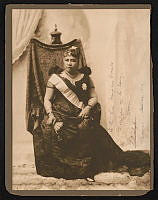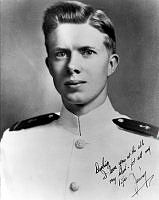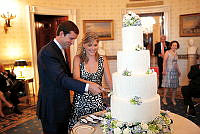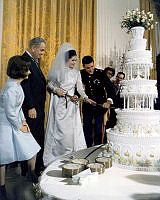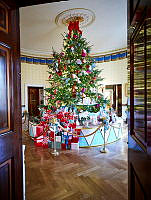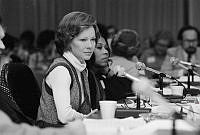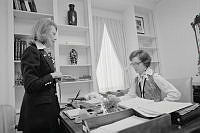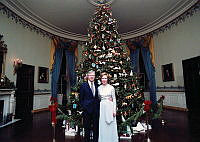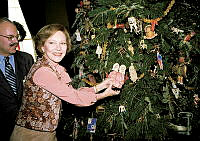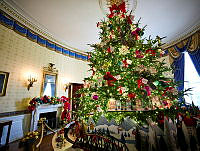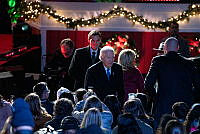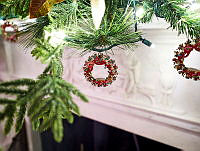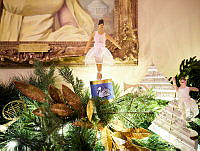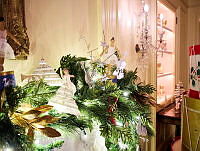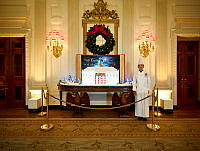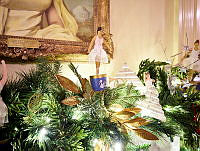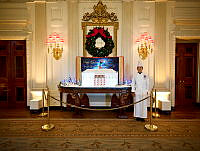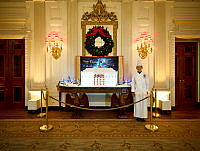Rubenstein Center Scholarship
An American Icon
The Many Roles of Dolley Madison
Savior of American portraiture, server of ice cream, dual term first lady and mentor of White House hostesses: all of these titles characterize Dolley Madison’s time in the White House. These aspects are just some of the many highlights of Dolley and her presence in American collective memory. She was idolized not just by her peers, but also by Europeans as well. In 1818, the wife of the Swedish minister, Lucia Alice von Kantzow, admiringly wrote to Dolley that she was, “loved by all [her] country men and country women.”1 An obituary published by the National Daily Intelligencer affirmed this statement more than thirty years later by describing Mrs. Madison as “beloved by all who personally knew her, and universally respected, this venerable Lady closed her long and well-spent life with the calm resignation which goodness of heart combined with piety only can impart.”2 While she received acclaim throughout James Madison’s presidency, Dolley Madison achieved popularity and respect in her own right, especially upon her return to Washington, D.C. after her husband’s death in 1836. Dolley Madison remained an influential force over the social function of the White House through her longstanding public status in the capital. In this position, she served as a confidante to subsequent presidents through her mentorship of first ladies and touted her relationship to the past through personal connections with the Founding Fathers.

The 1804 Gilbert Stuart portrait of Dolley Madison.
White House Historical Association/White House CollectionAfter her husband’s death, Dolley moved to Washington, D.C. to live in a house on the northeast corner of Lafayette Square. In the vicinity of the White House and within the “President’s Neighborhood,” Dolley returned to the D.C. social scene by the means of her new residency. The Cutts-Madison House was built in 1820 by Richard Cutts, a Massachusetts congressman who had married Dolley’s sister, Anna.3 The mortgage was passed on to James and then to Dolley, who resided there until her death in 1849.4 Yet when she relocated in 1837, Dolley’s reputation transformed her new home into a center of social affairs in the capital city.5 Contemporary journalist Anne Royall would later reflect upon Dolley’s hostess skills: “No wonder she was the idol of Washington– at once in possession of everything that could ennoble a woman. But chiefly, she captivated by her artless, through warm, affability…. Her power to please– the irresistible grace of her every movement– sheds such a charm over all she says and does that it is impossible not to admire her.”6 Royall would certainly not be the last to admire Dolley Madison’s social grace either.
Victorian America adored Mrs. Madison for her style and talents in hospitality that had benefited her husband’s political career and national image.7 Dolley possessed decades worth of experience entertaining politicians and social elites of the capital by the time she returned to Washington. In her role as a socialite, Dolley had access to prominent American figures, sharing her unique experiences with them on a regular basis. Throughout her residency from 1837 to 1849 as a neighbor to the presidents, Dolley Madison met frequently with a number of first ladies. While it is likely apocryphal that President Zachary Taylor referred to Dolley Madison at her funeral as the first president’s wife to be called “First Lady,” it is true that she had a strong influence on the role of the president’s wife that would eventually receive this title.8 Passionate about public service, Dolley set a standard for the constantly evolving role. Through an acute awareness of politics and a proclivity for parties, Dolley Madison understood that entertainment was a platform for lobbying while establishing authority and loyalty within one’s own political party.9 However, in many instances throughout Dolley Madison’s life, she attended and planned these events in support of her husband’s career. As historian Catherine Allgor contends, “Dolley and women like her…were the essentially conservative wives, mothers, and daughters of political families, and they saw their work as furthering their families’ interests.”10 Dolley Madison passed on all of these lessons to the succeeding first ladies she mentored during her time in Washington.

The Cutts-Madison House on the northeast corner of Lafayette Square.
White House Historical AssociationFirst Ladies Julia Gardiner Tyler and Sarah Childress Polk, as well as hostess Priscilla Cooper Tyler, the president’s daughter, all welcomed advice from Dolley Madison on how to operate in their positions.11 One of Dolley Madison’s last documented appearances in public was a visit to the White House to see President James K. Polk and First Lady Sarah Childress Polk. It is also believed that Dolley introduced Angelica Singleton to President Martin Van Buren’s son Abraham, as Singleton was a cousin of Mrs. Madison.12 As the daughter-in-law to President Van Buren, Singleton became the acting first lady for the Van Buren administration. Dolley Madison advised all of these women in some capacity, all of whom had a vital role to play within the White House. In close proximity to the presidents, these ladies had the ability to affect their husbands or fathers through the guiding words of Dolley Madison. Madison was deemed a reliable source not only for her decades’ worth of experience, but also for her own connection to the Founding Fathers.
Dolley Madison knew all twelve presidents during her lifetime.13 As someone who personally interacted with figures such as George Washington and Thomas Jefferson, Dolley Madison became an icon of the Founding Era. She even recounted the lives of the Founding Fathers and drew on her own memories and objects associated with them.14 Dolley was not only connected personally to the Founding Fathers, but in American memory as well. Most notably, Dolley Madison is credited with saving the Gilbert Stuart portrait of George Washington during the burning of the White House in 1814, a claim she herself cultivated and promoted throughout her lifetime. When Dolley realized that little could be taken from the home in that moment, she deemed the painting and her husband’s papers worth saving.15 While rescuing presidential correspondence and plans of war protected her husband, Dolley Madison saved the painting of George Washington for all of the American people. At this time in the United States, George Washington was an idolized figure. Mrs. Madison would later remark that she saved the portrait out of “my respect for General Washington.”16 But in this context, the first presidential portrait can be understood as a representation of the American people; if the British captured this painting, then perhaps it was possible for British to regain control over America. Dolley Madison understood the symbolism behind this political dilemma and took action, or so the story goes.

This Gilbert Stuart painting of George Washington was purchased by the federal government and installed in the White House in November 1800. First Lady Dolley Madison's order to save the portrait, along with the actions of those at the President's House, ensured that this valuable artwork survived the burning by the British in 1814.
White House Historical Association/White House CollectionIn A Colored Man’s Reminisces of James Madison, Paul Jennings refuted this American lore stating, “This is totally false. She had no time for doing it. It would have required a ladder to get it down …. John Susé [Jean-Pierre Sioussat, the doorkeeper] …. and Magraw, the President’s gardener, took it down and sent it off on a wagon, with some large silver urns and such other valuables as could be hastily got hold of.”17 Yet this version of the story would not have excited Americans in quite the same way. As historian Catherine Allgor noted, “Dolley’s flight from the White House had captured the public imagination, building on her already larger-than-life image.”18 This example of American folklore is comparable with the many myths surrounding George Washington, and stands as a testament to the person Dolley Madison was and how she is remembered in popular memory.
In some instances, Dolley Madison was regarded as a "relict" of the early Republic and the Founding Era.19 Through her own symbolic value in American memory, Dolley was referred to in the Boston Cultivator in 1846 as “justly regarded as one of [Virginia’s] monuments.”20 She was a daughter of the American Revolution, representing a generation of women who fought to secure and sustain independence. As historian Allen Clark claimed, “She was the first lady when the second war with Great Britain was declared; she was the first lady at its close. Then Dolley Madison is a Daughter of the American Revolution and she is the eldest daughter of its confirmation.”21 This is not the only symbolic role Dolley Madison held on account of her significance. She also held an honorary seat in Congress, which allowed her to listen to debates on the floor.22 Upon appointment in 1844, Dolley Madison responded, “Permit me to thank you Gentlemen, as the Committee on the part of the House of Representatives, for the great gratification you have conferred upon me this day by the delivery of the favor from the Honorable Body allowing me a seat within its Hall.”23 In her day, Dolley Madison existed as an American icon and she remains so to this day.

This ca. 1840 watercolor of Dolley Madison is attributed to her niece, Mary Estelle Elizabeth Cutts.
White House Historical Association/White House CollectionWhen assessing Dolley Madison’s position in the American historical narrative, it is essential to consider her influence over the presidency and the American people through her roles as socialite, confidante, and icon in American culture. As Catherine Allgor argues, “While her culture could not openly acknowledge her political power, her association with charm, femininity, sociability, and Americanness proved so powerful and enduring that her image and name became a commodity for many businesses, corporations, and organizations.”24 This kind of veneration is typical reserved for presidents, not necessarily first ladies. However, Dolley Madison was cognizant of the image she conveyed to the American public and strove to fulfill the ideals that gave her popularity and a prominent place in American history. Although remembered in her later years as a link to the Founding Fathers, a valuable resource to first ladies, and a gracious hostess to all, Dolley Madison did not recognize herself fully in these capacities. Instead, Dolley saw herself in a role most did not witness, as a writer of poems and epigrams.25 Expressed to her niece, Mary Cutts, Dolley embodied her own advice, “We have all, a great hand in the formation of our own destiny. We must press on, that intricate path, leading to perfection and happiness, by doing all that is good and handsome before we can be taken under the silver wing of our rewarding angel.”26 Dolley Madison is remembered in American memory for doing just this.













